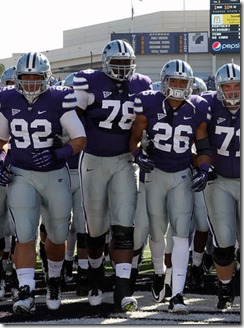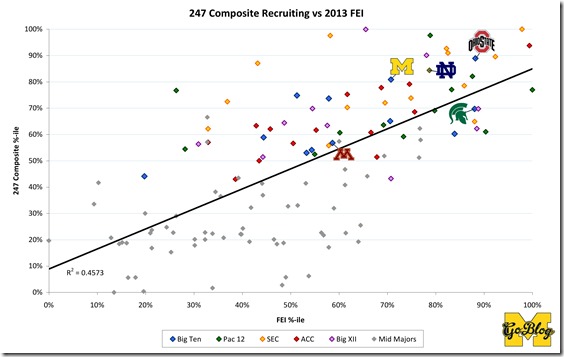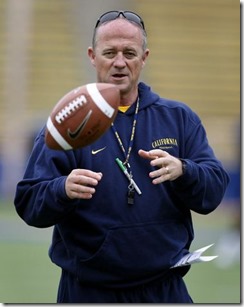Hokepoints is Legit, Maybe Not Legit. Yo.

Moe (1) and Jabrill (2), via.
In last week's roundtable on the state of the conference I pulled out this table grading the new Big Ten's teams on their 2013 seasons (by Fremeau Efficiency Index) and their futures (by composite 247 score for the 2012-'14 classes):
West | East School FEI Grade Rcrt | School FEI 2013 Rcrt Wisconsin 13th A C+ | OSU 8th A A+ Iowa 30th B C | MSU 9th A B Minnesota 49th C D+ | Michigan 29th B A+ Nebraska 51st C B | Indiana 62nd D+ C NW'ern 60th C- C | PSU 65th D+ B Illinois 75th D C- | Maryland 74th D C+ Purdue 114th F C- | Rutgers 98th E- B- AVG 56th 2.0 2.0 | AVG 49th 2.1 3.0 …
That's about how I feel: A conference baseline of "C" (ie ranked around 50th) teams with one division recruiting at a "B" level and the other "getting the most out of" C level recruiting.
This I pulled from a spreadsheet of FEI and recruiting data that I'd like to mine further, because if you're looking at a chart it still counts as doing work.
Recruiting = legit, yo/maybe not so legit. So here's a new look at the old stand-by: recruiting on the Y-axis, performance on the X-axis, and a nice, heavy trend line with an R-squared of 0.46 to show an inconvenient-for-narratives correlation. Performance is FEI expressed as a percentile. The composite ranking is a bit more complex: the 2009 (5th year seniors) is weighted at 0.5 the 2010 and 2011 classes at full, the 2012 class at 0.40 and the 2013 at 0.10, which are arbitrary values I assigned based on expectations of how much a class contributes to a given team.
Blicking on it makes it cig.
It says they're correlated, but doesn't necessarily mean one is causing the other. FWIW the r-squared of the Rivals composite determined the same way was .4135; I haven't done Scout or ESPN yet. Look at how the correlation of recruiting %-ile of each class and 2013 performance %-ile changes by year:
| Class | 247 R-Squared | Rivals R-Squared |
|---|---|---|
| 2009 (5th yrs) | 0.3681 | 0.3204 |
| 2010 (Jr/Sr) | 0.3696 | 0.3776 |
| 2011 (So/Jr) | 0.4596 | 0.3848 |
| 2012 (Fr/So) | 0.4143 | 0.4134 |
| 2013 (RS/Fr) | 0.4724 | 0.4076 |
| 2014 (recruits) | 0.4417 | 0.4098 |
The highest correlation is to the freshman class, and the 3rd-highest is to the class that's not even on campus yet. There's a strong echo effect going on here, wherein the teams that are good today are getting the highest-ranked recruits. The diminishing returns from seniors, I would posit, are because they're the classes hit hardest by attrition, and most likely to have been recruited by a different coach or to a program in very different circumstances.
The other thing that immediately jumped out at me about that chart is look at all the color on top of the black trend line. Those gray dots are mid-major programs, who are largely outperforming expectations from recruiting, versus only one SEC team managing to do so. I bet that's a system bias in the recruiting rankings: there's little to parse between an under-the-radar guy who commits to Purdue versus one going to NIU except one of those is a Big Ten school.
[Jump for MEETING EXPECTATIONS and THE FUTURE]
Meeting expectations. Here's the BCS schools significantly (more than 0.1 difference between FEI %-ile and recruiting composite %-ile) outperforming their freshman talent acquisition rate:
 |
| Over 50% of KSU's starters went the JUCO route. [Jamie Squire, SBNation] |
| Team | Conf | FEI | 247 Cp | Diff |
|---|---|---|---|---|
| Arizona St | Pac 12 | 90% | 61% | +30% |
| Kansas St | Big XII | 71% | 43% | +28% |
| Baylor | Big XII | 89% | 62% | +27% |
| Stanford | Pac 12 | 100% | 76% | +24% |
| Missouri | SEC | 88% | 65% | +23% |
| Wisconsin | Big Ten | 84% | 61% | +23% |
| Okla St | Big XII | 89% | 70% | +19% |
| Michigan St | Big Ten | 88% | 70% | +18% |
| Duke | ACC | 68% | 51% | +17% |
| Arizona | Pac12 | 73% | 59% | +14% |
| Washington | Pac12 | 80% | 69% | +11% |
I don't know what it means except ungh MSU and ungh Arizona of course would be on there. As for Michigan's bowl opponent, that's less of a "finds and develops" thing than that Bill Snyder is heavily reliant on JUCO transfers, who don't show up in the recruiting rankings so much. The only SEC team in there is Missouri, who wasn't in the SEC when they were rating their recruits and got a nice boost from much of their SEC-Eastmates being actually pretty crappy teams this year. It could mean they're overrated; it could mean the way Brian Fremeau does his statistics hurts teams that play a lot of tough conference opponents alongside a nonconference spate that Michigan's Team 7 would have found appalling.
As for the underperformers:
| Team | Conf | FEI | 247 Cp | Diff |
|---|---|---|---|---|
| California | Pac12 | 26% | 77% | -51% |
| Tennessee | SEC | 43% | 87% | -44% |
| Florida | SEC | 58% | 98% | -39% |
| Arkansas | SEC | 37% | 72% | -36% |
| Texas | Big XII | 66% | 100% | -34% |
| Kentucky | SEC | 33% | 62% | -29% |
| Kansas | Big XII | 31% | 57% | -26% |
| Colorado | Pac12 | 28% | 54% | -26% |
| Penn State | Big Ten | 51% | 75% | -24% |
| N.C. State | ACC | 33% | 57% | -24% |
| Purdue | Big Ten | 20% | 43% | -23% |
| Virginia | ACC | 43% | 63% | -20% |
Horray Michigan isn't on the list. The next 10% is USC, Maryland, Nebraska, West Virginia, Texas Tech, Illinois, North Carolina, Oklahoma and LSU. We're at –9%, in a pile with Miami (YTM) and Georgia.
After Cal, however, the teams on this list suggest Michigan has to do a lot more than wait for the 2012 and 2013 kids to mature. Tennessee, Florida, Arkansas and Texas had comparable classes in 2010 and 2011, though there's some coaching changes in there that change things a bit.
Ohio State broke even, but that's about as well as they can do since they're 98th percentile in recruiting. That is the goal.
------------------------------------
Trending the Good Way. Michigan's top-o'-the-country recruiting has been of recent vintage. Other teams with significant recent leaps from their norms: Texas A&M, Vanderbilt, Miami, Baylor, Purdue, KSU, Zona, Ohio State, and Syracuse. Of these just Miami is around the same base level. You'll recognize the teams on the opposite side of the ledger: USC, Cal, Texas, Oklahoma, Kansas, Penn State: fading stars.
But knowing where teams are today doesn't help. I want a comparison from recent history so I grabbed three 2010 teams with a similar profile to 2013 Michigan's and tracked them over the next three seasons. And that was pretty useless but here it is anyway:
| Team | FEI | Rec | So | Fr | Recr | 1 yr | 2 yrs | 3 yrs |
|---|---|---|---|---|---|---|---|---|
| 2013 Michigan | 0.122 | 7-5 | 6th | 4th | 13th | ? | ? | ? |
| 2010 Team 1 | 0.124 | 8-5 | 3rd | 3rd | 3rd | 10-2 (7-2) 6th in AP 10th in FEI | 7-6 (5-4) Unranked 30th FEI | 9-4 (6-3) Unranked 18th FEI |
| 2010 Team 2 | 0.120 | 8-5 | 24th | 18th | 33rd | 7-6 (4-5) Unranked 16th in FEI | 11-2 (6-2) 5th AP 3rd FEI | 8-4 (4-4) 20th AP 25th FEI |
| 2010 Team 3 | 0.123 | 8-4 | 19th | 28th | 32nd | 7-6 (2-6) Unranked 47th in FEI | 8-5 (4-4) Unranked 62nd FEI | 6-6 (3-5) Unranked 42nd FEI |
| 2010 Team 4 | 0.130 | 5-7 | 29th | 28th | 10th | 10-4 (6-2) 22nd AP 32nd FEI | 11-2 (7-1) 11th AP 25th FEI | 8-2 (7-1) 12th AP 26th FEI |
Not really helpful. Team 1 is USC, which Lane Kiffin. Team 2 is Texas A&M, which Johnny Football. Team 3 is Mississippi State, which very much isn't Michigan fergodsakes. Team 4 is Clemson. If Devin turns into 2005 Vince Young next year, upside seems pretty possible; cliffs are everywhere. Then again look what Lane Kiffin could do with just slightly more incoming talent, and the worst Borges hater would take a midseason tackle-over intermission any year to avoid goat boy.
December 17th, 2013 at 3:43 PM ^
December 17th, 2013 at 5:22 PM ^
December 17th, 2013 at 6:14 PM ^
is worth at least 1-2 stars. That is, the average star ratings of the recruits have to be adjusted for the ability of the staff to develop players. I would add these:
UM = 0
MSU = 1.5
OSU =0
Wisc = 1 (the old regime)
Iowas = 1
Rest =0
December 17th, 2013 at 7:51 PM ^
I'm really surprised to see FEI rank us so high in the Big Ten, especially ahead of Iowa and Nebraska. It lends credence to the idea that everybody (except Minnesota) gets up for Michigan, while it's tough for us to play our "A" game week in and week out.
December 17th, 2013 at 8:48 PM ^



Comments